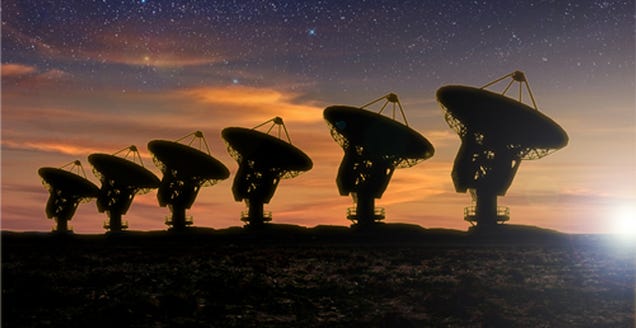
For nearly a decade, astronomers have puzzled over powerful bursts of radio energy that seem to be hailing from billions of light years away. Recently, we received reports of a new wrinkle to this mystery: The bursts appear to follow a mathematical pattern, one that doesn’t line up with anything we know about cosmic physics.
And, of course, when we hear “mathematical pattern,” “radio transmission,” and “outer space,” all strung together, we immediately jump to our favorite explanation—aliens! (Or, you know, a decaying pulsar star, an unmapped spy satellite, or a cell phone tower.)
It’s also possible that the pattern doesn’t actually exist.
Since 2007, telescopes have picked up nearly a dozen so-called “fast radio bursts,” pulses that last for mere milliseconds, but erupt with as much energy as the sun releases in a month. Where could they be coming from? To find out, a group of researchers took advantage of a simple principle: That higher frequency radio waves encounter less interference as they traverse space, and are detected by our telescopes earlier than lower frequency waves. The time delay, or “dispersion measure”, between higher and lower frequency radio waves from the same pulse event can be used to determine the distance those waves traveled.
Here’s where things got weird. When researchers calculated the dispersion distance for each of eleven fast radio bursts, they found that each distance is an integer multiple of a single number: 187.5. When plotted on a graph, as the researchers show us in Figure 1 of their paper, the points form a striking pattern.
One explanation is that the bursts are coming from different sources, all at regularly spaced intervals from the Earth, billions of light years away. They could also be caused by a small cosmic object much closer to home, such as a pulsar star, behaving according to some sort of physics we don’t yet understand. And then there’s the possibility that aliens are trying to communicate, by blasting simple numeric patterns into space.

But no matter how you slice it, eleven data points is a small sample set to draw any meaningful conclusions from. A handful of deviant observations could cause the entire pattern to unravel.
And that’s exactly what seems to be happening. As Nadia Drake reports for National Geographic, newer observations, not included in the latest scientific report or other popular media articles, don’t fit:
“There are five fast radio bursts to be reported,” says Michael Kramer of Germany’s Max Planck Institute for Radioastronomy. “They do not fit the pattern.”
Instead of aliens, unexpected astrophysics, or even Earthly interference, the mysterious mathematical pattern is probably an artifact produced by a small sample size, Ransom says. When working with a limited amount of data – say, a population of 11 fast radio bursts – it’s easy to draw lines that connect the dots. Often, however, those lines disappear when more dots are added.
“My prediction is that this pattern will be washed out quite quickly once more fast radio bursts are found,” says West Virginia University’s Duncan Lorimer, who reported the first burst in 2007. “It’s a good example of how apparently significant results can be found in sparse data sets.”
That’s a bit of a bummer, but still, these radio bursts are fascinating, and what could be causing them remains as much of a mystery as ever. It could even still be aliens, if not an alien beacon. As SETI Institute Director Seth Shostak told me in an email:
“If it’s a signal, well, it’s certainly NOT a message — except maybe to say ‘here we are’. There’s not real bandwidth to it, which means these fast radio bursts can’t encode many bits. But there are so many other possibilities, I think that automatically attributing something in the sky that we don’t (at first) understand to the work of aliens is … premature!”
If there’s one thing that is clear in this whole business, it’s that we’ve still got plenty to learn about the patterns woven into the universe around us.
Read a pre-print of the scientific paper on arXiv.
Images: Shutterstock, Hubble via Flickr
Follow Maddie on Twitter or contact her at maddie.stone@gizmodo.com
from ffffff http://gizmodo.com/an-alien-radio-beacon-probably-not-this-time-1695628907
via IFTTT







0 comentarios:
Publicar un comentario